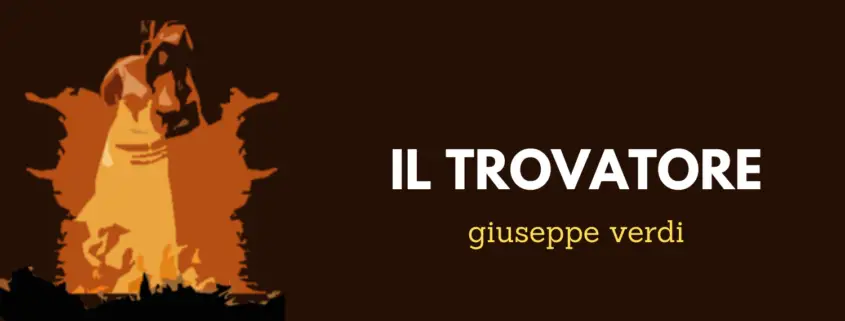The Portrait of Verdi’s Aria DI QUELLA PIRA
Read Interesting facts and hear great YouTube Videos about the famous Aria “DI QUELLA PIRA”.
If you want to hear more about the opera Il Trovatore, click on the link to the opera portrait
The Aria – Synopsis & Background
Synopsis: Luna attacks the fortress of Manrico. Manrico defends it as leader. Manrico swears eternal faith to Leonora to the death. Manrico has every reason to be in a furor: his mother Azucena has been captured by the Conte di Luna and taken hostage. Luna threatens her with death at the stake. Manrico wants to free Azucena and says goodbye to Leonora.
The aria ‘di quella pira’ together with ‘ah si ben mio’ forms a ‘scena ed aria’. This is a composition convention from the “Rossinian” Belcanto era. It describes very schematically a sequence of arias. The sequence was: recitative (tempo d’attacco), slow aria (Cavatina, «Ah si ben mio»), recitative (tempo di mezzo), fast aria (Cabaletta, «di quella pira» ).
This aria is a touchstone for tenors. The music is rousing: it begins in Allegro and is then enhanced five times with musical effects. First the tenor has to increase the volume (Verdi writes “con tutta forza” in “Col sangue vostro”), in the middle the tempo is increased (“piu vivo” in “morir”), next the choir enters, then the tenor joins in and at the end the tenor sings the highest note. This dramaturgy triggers an ecstatic effect on the listener.
In addition to this stylistic element, the aria has two other characteristic features. One is the element of sixteenth-note quadruplets:
The tenor must sing this element in each verse, which adds up to no less than thirteen repetitions. This figure is supposed to symbolize the flickering of the fire “The flames of that terrible pyre, inflamed and consumed all my being”). It is supposed to let the burning of the pyre pass in front of the listener’s mind’s eye. This element is made of semitone intervals and is not easy to sing in Allegro.
The accompaniment of the orchestra has a striking forward thrust, the rhythm is similar to a polonaise. It symbolizes the battle to be fought and is reinforced by the entering choir of warriors.
The second characteristic feature of the aria is the famous high C at the end. Interestingly, Verdi did not compose a high C at this place. However, one of the first tenors of this opera explicitly asked Verdi for permission. Verdi expressly permitted this, provided that the C was sung beautifully. So this convention has prevailed and most listeners know the aria exactly this way, so following the original score would cause irritation, if not disappointment, among the audience. Even Toscanini, who banned all freedoms taken by singers in the 19th century, accepted the convention.
In the year 2000, to celebrate the 100th anniversary of Verdi’s death at the milan opera house “la scala”, Riccardo Muti ordered the tenor to sing this aria in the original version, without the high C. After the aria there was a hail of booing and the result was a theatre scandal that moved the press and minds for days on end.
The Aria – the text of DI QUELLA PIRA
Di quella pira l’orrendo foco
Tutte le fibre m’arse avvampo…
Empi spegnetela, o ch’io tra poco
Col sangue vostro la spegner?…
Era gia figlio prima d’amarti
Non puo frenarmi il tuo martir.
Madre infelice, corro a salvarti,
O teco almeno corro a morir!
Vocal Fach «Spinto Tenor»
The role of Manrico is written for a spinto tenor (Italian) respectively young heroic tenor (German). The voice is strong and masculine. It has a metallic brilliance in the high notes. It captivates with its effortless power in the higher tessitura and has still agility. In the high register the Spinto Tenor can inspire the audience with top notes.
Famous interpretations of DI QUELLA PIRA
Jussi Björling is the tenor with the most recordings of the Trovatore. He has made a total of six recordings of this opera. For this article I chose the 1952 recording. On the day of the recording he wrote to his wife “I have never sung di quella pira as well as today”.
Björling’s melancholic timbre is in full bloom in the passage “Era gia figlio prima d’amarti Non puo frenarmi il tuo martir” (Your torments won’t stop me Unhappy mother, I run to rescue you).
Also his high C is extraordinary. His effortless attacking of the high C remains unmatched.
Di quella pira (1) – Björling
The trovatore was one of Franco Corelli’s key roles. Only a few can keep up with the Italian in vocal power.
Di quella pira (2) – Corelli
In his 1906 recording Enrico Caruso sings the sixteenth-note quadruplets precisely and somewhat more slowly than other tenors. However, the aria was transposed half a tone down and it does not end with the C but on the Bb. Caruso had a baritone coloured voice. Although he reached the high C, he also avoided it occasionally when it was not convenient. He shares this habit with other tenors. (del Monaco, Domingo, Carreras, Tucker, Gigli, Pertile…).
Note the famous Caruso sobbing in “madre felice”, with which he “made an expressive piece out of the martial tenor fanfare” (Kesting).
Di quella pira (3) – Caruso
A beautiful recording of Pavarotti from 1968. He sings a spectacular High C. In later years he too occasionally chose the Bb.
Di quella pira (4) – Pavarotti
On a tip in a comment of the blog by Anton Honegger you will find the great version by Franco Bonisolli. I didn’t know the version. Great discovery: a true knight of the high C’s !
Di quella pira (5) – Bonisolli
Peter Lutz, opera-inside, the online opera guide to the Aria “di quella pira” from the opera Il trovatore.




Leave a Reply
Want to join the discussion?Feel free to contribute!